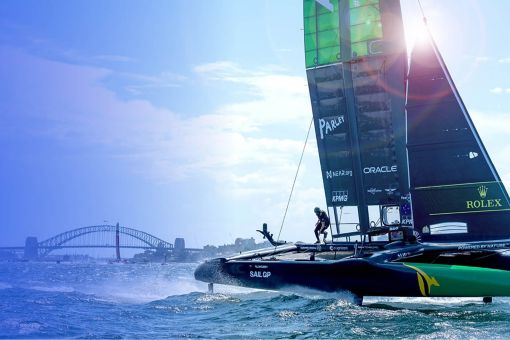How an organisation addresses climate change and ESG risks is fundamental to its long-term sustainability and performance. Yet, as policies and legislation evolve, understanding what data to capture and how to measure progress can become complex.
An Engine of possibilities
Inspired by grand prix racing on water and fuelled by the power of nature, the SailGP Power Potential Engine delivers a suite of analytics and insights that provoke organisations to view their everyday performance metrics through a sustainability lens – identifying business areas of potential, then making positive change for a more sustainable future.
Get in touch
Learn more about the SailGP Power Potential engine and how it could help develop and measure your organisation’s sustainable practices.
Using data and AI to display the power of nature
Power Potential was born from KPMG and Oracle’s collaboration with SailGP, the world’s most exciting race on water, where grand prix racing demonstrates the boundaries of performance and highlights the advantage of renewable energy for a more sustainable sports industry.
The incredible technology and engineering behind SailGP’s global sporting league generates a significant amount of clean energy, and is visualised through KPMG’s Power Performance engine using a combination of Oracle Cloud platform components and AI. This information is then fed back into the platform for near real-time analytics, piquing interest beyond sport.
How it works: SailGP Power Potential Engine in action
Data capture
The Power Potential engine accesses millions of remote, telemetry data points generated from each of the SailGP teams, captured using sensors from solar panels, sails and hydro equipment, via Oracle OCI.
Data interpretation
Using AI, the engine employs tools like Oracle's low code application builder APEX and relevant web applications to decipher the information and translate it into meaningful insights.
Real-world context
The data is brought to life visually by comparing the energy generated by the yachts to real-life use cases that matters to people and business - highlighting the power of a renewable energy strategy.
Better decision-making
These insights into efficient energy usage offer SailGP near real-time information and opportunities for their continued progress towards greener and sustainable business practices.
Examples: Generating green energy with sail power
Using our methodology, the SailGP global league has the potential to produce enough energy to:
Power Potential – FAQs
-
What is the methodology for the Power Potential engine? To understand the total kilowatts per hour (kWh) generated by each SailGP boat, we determined the lift force produced by each yacht by measuring its air, wind, design and sail size characteristics, using the following equation:
Lift force = 0.5 x rho x V x V x Cl x A
To demonstrate the total power generated from SailGP in a real-world setting, we then combined the energy output from all six races, including the final, with a hypothetical scenario that the race would run for 12 hours per week.
-
What are the formulas behind the examples provided on the engine? Using our methodology above and the formulas below, the SailGP global race produces enough energy to:
Power 241,972.16 smartphones for a year
- Power to charge a smartphone = 0.022 kWh1
- Formula used:
Power generated from SailGP (kWh) / Power to charge a smartphone (kWh) / 300
Power 13.7 Australian primary schools for a year
- Average Australian primary school energy consumption for a year = 116,000 kWh2
- Formula used:
Power generated from SailGP (kWh) / Average annual Australian primary school energy consumption
Power one average Australian public hospital for 387 years
- Number of public hospitals in Australia = 6973
- Total Australian public hospitals’ energy consumption for a year = 4,122 kWh4
- Average Australian public hospital energy consumption for a week = 4,122,000,000 / 697 / 52 = 113,729 kWh
- Formula used:
Power generated from SailGP (kWh) / Average Australian public hospital energy consumption for a week
Power an electric vehicle – kilometres travelled
- Efficient electric vehicle energy consumption per km = 0.15 kWh5
- Efficient electric bus energy consumption per km = 1.2 kWh6
- Efficient electric truck energy consumption per km = 1.86 kWh7
- Total distance to circumnavigate entire coast of Australia (km) = 15,000 km 8
- Formula used:
Power generated from SailGP (kWh) / Efficient EV’s energy consumption per km / Total distance to circumnavigate entire coast of Australia (km)
Power 65 small Australian businesses for a year
- Average to run a small business in Australia for a year = 24,500 kWh 9
- Formula used:
Power generated from SailGP (kWh) / Average to run a small business in Australia for a year
Reduce 803 tonnes of carbon per year
- Australia baseline carbon intensity = 503.18g CO2/kWh10
- Formula used:
Power generated from SailGP (kWh) x Australia baseline carbon intensity / 1,000,000
Sources
- Greenhouse Gases Equivalencies Calculator - Calculations and References
- Energy consumption in Australian primary schools: Influences and metrics
- Australia's hospitals at a glance
- Renewable energy use in Australian public hospitals (PDF 297KB)
- What is a good energy consumption figure for electric vehicles?
- Comparative Assessment of Zero Emission Electric and Hydrogen Buses in Australia (PDF 2.1MB)
- Analysis of advanced battery-electric long haul trucks
- How Long Does It Take To Drive Around Australia?
- How much electricity does a business use?
- kWh to CO2 Calculator
-
What are the future plans for SailGP’s Power Potential engine? Innovative technology is always looking for ways to evolve. The future of the Power Potential engine includes adding more functions that can be applied across SailGP’s broader ecosystem, e.g. how can SailGP use this information across its back office to simplify logistics, reduce the brand overall impact, link to their impact league and include in their broadcasts.
-
How can the Power Potential engine improve organisational decision-making? Sustainability and ESG are key themes for organisations, as proven through multiple climate summits, legislation and policy positions taken globally every year – which all point to one thing – we must act now, to create a sustainable future for everyone.
Yet many organisations can be stuck knowing their next step as sustainability expectations evolve. They feel unsure how to answer questions like what data to capture, how to measure progress or bring their people on the journey.
The Power Potential engine allows organisations to view their everyday performance metrics through a different lens, providing new and different. It offers a suite of tools and capabilities to help businesses change their capacity to act and bring about a more sustainable future. This is done by leveraging AI, efficient energy usage, decarbonisation, lower energy bills and corporate social responsibility to measure where a business is generating their positive potential and identify ways to improve.
-
Where is the data stored? SailGP uses Oracle Autonomous Data Warehouse, Oracle Apex and Oracle Stream Analytics.
SailGP Power Potential Dashboard
Learn more about the SailGP Power Potential engine and view real data from SailGP events around the world.
How Power Potential can benefit business
Power Potential goes beyond calculating the power generated from a F50 catamaran. Its capabilities extend to capturing, repurposing, analysing, and visualising performance data to drive new sustainability insights, including highlighting the negative environmental impacts an organisation has already avoided.
By analysing performance data with a sustainability lens, companies can track their carbon emissions, energy use, and social responsibility, which in turn can guide them to make smarter, more impactful business decisions for the future.
For example: Solving the energy crisis is one of the most essential undertakings of the 21st century for both government and industry sectors. Where and how organisations can obtain and finance energy in ways to provide for efficient use, reduce environmental impact and remain cost-effective is fundamental initiative leaders are grappling with. The power potential dashboard illustrates how business leaders could view their existing data with a new lens to better understand the implications of their energy choices and help them with better more sustainable decision making for the future.
Get in touch
Please get in touch to learn more about the SailGP Power Potential engine and how it could help develop and measure your organisation’s sustainable practices.










